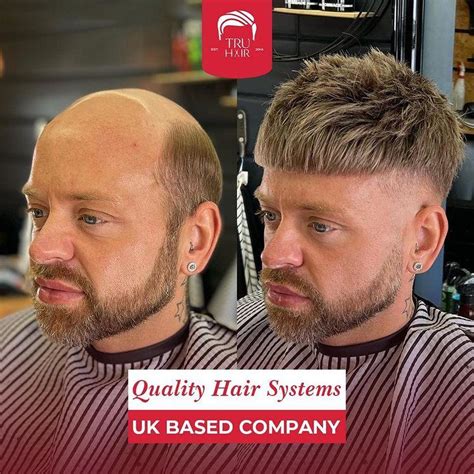Losing hair can be a devastating experience for men, affecting their self-confidence and overall well-being. The good news is that there are now numerous hair replacement options available, including hair systems. These systems offer a natural-looking, durable, and versatile solution to hair loss.

1. Polyurethane Hair Systems
Polyurethane hair systems are bonded to the scalp using a medical-grade adhesive. They are lightweight, comfortable to wear, and provide a natural-looking hairline. Polyurethane is also water-resistant, making it ideal for active men who enjoy swimming or exercising.
2. Lace Hair Systems
Lace hair systems are made from a delicate lace material that is attached to the scalp using glue or tape. They are lightweight, breathable, and virtually undetectable. Lace hair systems are particularly popular for men with fine or thin hair, as they allow for a seamless blend with their own hair.
3. Silicone Hair Systems
Silicone hair systems are made from a medical-grade silicone material that is bonded to the scalp using a permanent adhesive. They are durable, long-lasting, and require minimal maintenance. Silicone hair systems are ideal for men with chronic hair loss or scalp conditions.
4. Scalp Micropigmentation
Scalp micropigmentation is a non-surgical hair replacement technique that involves tattooing tiny dots of pigment into the scalp. It creates the illusion of hair follicles, resulting in a natural-looking, shaved head appearance. Scalp micropigmentation is ideal for men who prefer a permanent, low-maintenance solution.
- Natural results: Hair systems offer a realistic and natural-looking solution to hair loss.
- Comfortable and convenient: Hair systems are designed to be comfortable to wear and easy to maintain.
- Durable and long-lasting: Hair systems can last for several months with proper care.
- Versatile: Hair systems allow men to style their hair in a variety of ways.
- Boost self-confidence: Hair systems can significantly improve a man’s self-confidence and overall quality of life.
According to market research, the global hair systems market is projected to reach $8.9 billion by 2026. This growth is attributed to increasing awareness of hair loss solutions, advancements in technology, and the growing demand for non-surgical hair replacement options.
In addition to traditional hair replacement, hair systems are also being used for innovative applications:
- Medical treatments: Hair systems can be used to camouflage scalp scars or burns.
- Cosmetic enhancements: Hair systems can be used to add thickness and volume to thin hair.
- Entertainment: Hair systems are commonly used in the film and television industry to create different hairstyles and characters.
- Consult with a hair loss expert: Seek professional advice to determine the best hair system for your individual needs.
- Consider your lifestyle and budget: Choose a hair system that fits your lifestyle and financial situation.
- Research different types of hair systems: Explore the various options available to find the one that is most suitable for your hair loss pattern.
- Get a custom fit: Ensure that the hair system is tailored to your specific scalp shape and hair loss area.
- Clean your hair system regularly: Use a specialized hair system shampoo and conditioner to keep it clean and healthy.
- Store your hair system properly: When not in use, store your hair system in a cool, dry place.
- Avoid heat styling: Excessive heat can damage the hair system. Use low heat settings when using hair dryers or styling tools.
- Schedule regular maintenance appointments: Visit your hair loss expert for routine checkups and adjustments to ensure the hair system remains secure and in good condition.
- Prepare your scalp: Cleanse your scalp with a hair system shampoo and conditioner.
- Apply the adhesive: Apply a thin layer of medical-grade adhesive to the base of the hair system.
- Place the hair system: Carefully align the hair system with your scalp and press it into place.
- Secure the hair system: Apply pressure to the hair system to ensure it is firmly attached.
- Style your hair: Style your hair as desired using a hair dryer or styling tools.
Hair systems offer a proven and effective solution for men with hair loss. They provide a natural-looking, comfortable, and versatile option to regain a full head of hair. By carefully choosing and maintaining a hair system, men can restore their self-confidence and enjoy a better quality of life.
Tables
| Hair System Type | Pros | Cons |
|---|---|---|
| Polyurethane | Lightweight, comfortable, natural-looking hairline | Can be more visible than other types |
| Lace | Lightweight, breathable, seamless blend with natural hair | Requires more maintenance than other types |
| Silicone | Durable, long-lasting, minimal maintenance | Can be expensive |
| Scalp Micropigmentation | Permanent, low-maintenance, natural-looking shaved head appearance | Not suitable for all types of hair loss |
| Hair System Application | Step | Instructions |
|---|---|---|
| Preparation | 1 | Cleanse scalp with hair system shampoo and conditioner |
| Adhesive Application | 2 | Apply a thin layer of medical-grade adhesive to the base of the hair system |
| Placement | 3 | Carefully align the hair system with your scalp and press it into place |
| Securing | 4 | Apply pressure to the hair system to ensure it is firmly attached |
| Styling | 5 | Style your hair as desired using a hair dryer or styling tools |
| Hair System Maintenance | Task | Frequency |
|---|---|---|
| Cleaning | Use hair system shampoo and conditioner | Daily or as needed |
| Storage | Store in a cool, dry place | When not in use |
| Heat Styling | Use low heat settings | Avoid excessive heat |
| Regular Appointments | Visit a hair loss expert | Every 4-6 weeks |
| Hair System Market Statistics | Metric | Value |
|---|---|---|
| Global Market Size (2023) | $4.1 billion | |
| Projected Global Market Size (2026) | $8.9 billion | |
| Annual Growth Rate (2023-2026) | 15.1% |
